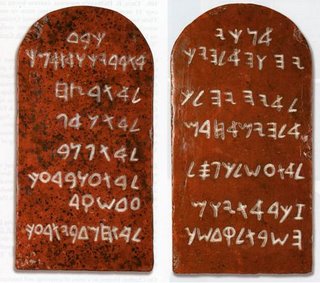 and, to a lesser extent, in his 1923 version.
and, to a lesser extent, in his 1923 version.
The "Hebrew Alphabet" that we know today, used for Hebrew since at least the 6th century BCE, is actually the Aramaic alphabet, which was in turn just a stylized version of the Phoenician alphabet. Since Phoenician, Hebrew and Aramaic are all closely related, especially the first two, no substantive changes to the alphabet were necessary for the use of the Phoenician alphabet in writing Hebrew or Aramaic. For Greek, on the other hand, many changes were needed. Most importantly, Greeks needed to write vowels. In a process that has been repeated countless times in history when a Semitic writing system was adapted for use with an non-Semitic language (Hittite, Etruscan, Greek, Farsi, Yiddish, Turkish, to name a few examples) obsolete consonants were recycled as vowels. But, as the Yiddish writer Abramovitsh's character Mendele says, נישט דאָס בין איך אױסן "nisht dos bin ikh oysn" - that's not my point.
No, my topic today is the complex relation of the two unvoiced dental consonants in each alphabet - θ (theta) and τ (tau) in Greek, and >ט (teth) and ת (tav) in Hebrew. Both ת and θ are often transliterated as "th" in the Roman alphabet, and as a result, modern words based on Greek roots are written in Hebrew with ת standing in for θ; thus the word for mathematics is מתמטיקה (m-th-m-t-i-k-h). It is slightly surprising, then, that in fact the correspondance between the two letters is reversed. You can see this two ways: one has to do with the position of the respective letters in their respective alphabets: theta comes between eta and iota, whereas tau comes after sigma. Likewise, teth comes between ḥeth and yod, and tav comes after sin. Also, consider the corresponding names: theta and teth, tav and tau. In fact consider teth, but flip around the th and the t, and you get "thet". Now do you believe me.
So how did it come about that the Roman alphabet grapheme "th" came to be used for Greek theta and Hebrew tau? The explanation is fairly simple: when Greek words were borrowed into Latin, "th" was used to show that the sound was an aspirated /t/, like in English 'top.' Get it? /t/+/h/= 'th'. At this point it might be useful to consider why the grapheme 'th' in English came to represent the sounds it does, namely voiced and unvoiced dental fricatives. According to the Wikipedia article on the subject,
By the time of New Testament Greek (koiné)... the aspirated stop had shifted to a fricative: /tʰ/→/θ/. Thus theta came to have the sound which it still has in Modern Greek, and which it represents in the IPA. From a Latin perspective, the established digraph now represented the voiceless fricative /θ/, and was used thus for English by French-speaking scribes after the Norman Conquest, since they were unfamiliar with the Germanic graphemes eth and thorn. Likewise, the spelling was used for /θ/ in Old High German prior to the completion of the High German consonant shift, again by analogy with the way Latin represented the Greek sound.
Philologists figured out fairly quickly that one function of the Hebrew letter tav must have been to represent an unvoiced dental fricative. These philologists, familiar with 'th' in OHG and English, rendered tav, when it was a continuant, as "th." Thus the relationship between the Greek letters and Hebrew ones was obscured.
No comments:
Post a Comment